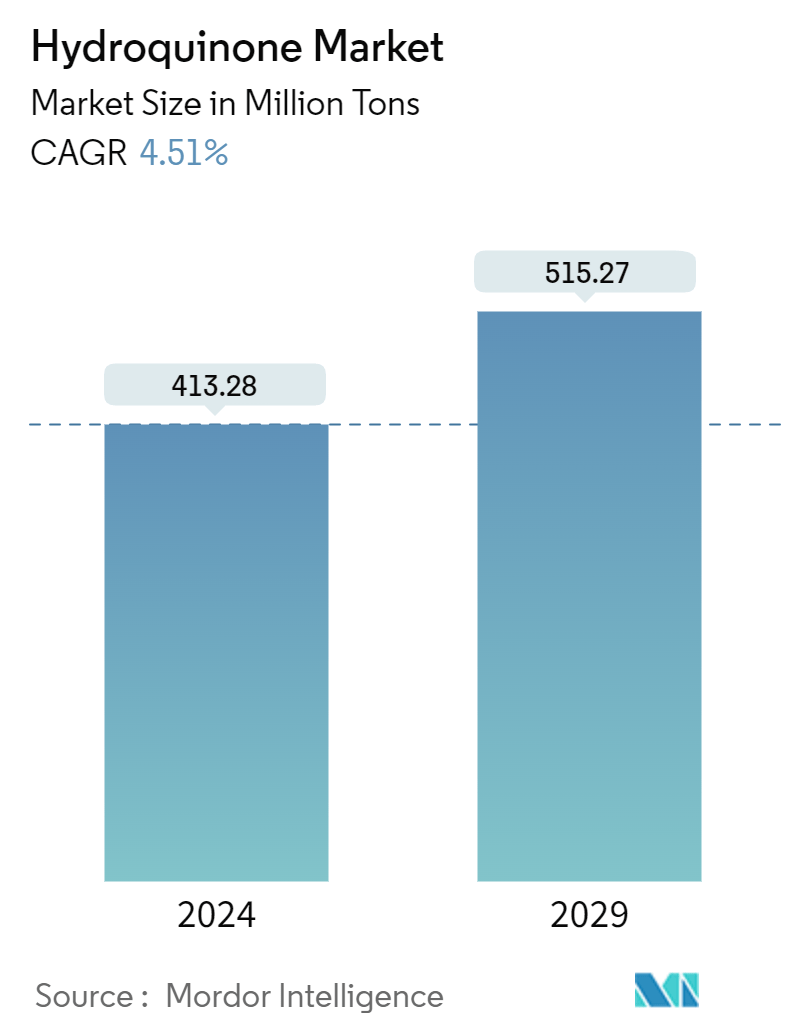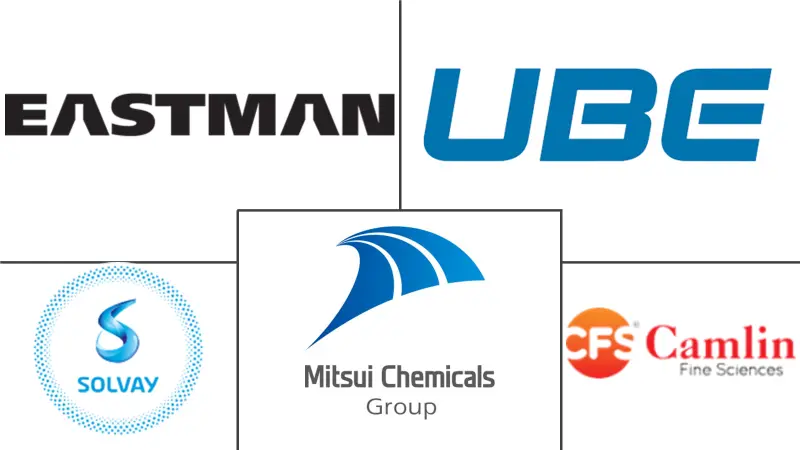Market Size of Hydroquinone Industry

| Study Period | 2019 - 2029 |
| Base Year For Estimation | 2023 |
| CAGR (2024 - 2029) | 4.51 % |
| Fastest Growing Market | Asia-Pacific |
| Largest Market | Asia-Pacific |
| Market Concentration | High |
Major Players
*Disclaimer: Major Players sorted in no particular order |
Hydroquinone Market Analysis
The Hydroquinone Market size is estimated at 413.28 Million tons in 2024, and is expected to reach 515.27 Million tons by 2029, growing at a CAGR of 4.51% during the forecast period (2024-2029).
- The market is likely to be propelled by the growing demand from the rubber and paint manufacturing industry during the forecast period.
- On the other hand, the toxic and cancer-causing effects of skin creams are likely to slow the market's growth over the next few years.
- The prevalence of hydroquinone in the pharmaceutical sector is expected to grow considerably during the forecast period.
- Asia-Pacific dominated the market worldwide, with the largest consumption coming from countries such as China, India, and Japan.
Hydroquinone Industry Segmentation
Hydroquinone is an aromatic compound manufactured during the synthesis of dyes, oils, motor fuels, etc. Hydroquinone is produced as an inhibitor, intermediate, and antioxidant during these processes. Quinol is another name for hydroquinone.
The hydroquinone market is segmented by application, end-user industry, and geography. By application, the market is segmented into intermediate, antioxidant, polymerization inhibitor, photosensitive chemical, and other applications. By end-user industry, the market is segmented into cosmetics, polymers, paints and adhesives, rubber, and other end-user industries. The report also covers the market size and forecasts for extruded polystyrene in 27 countries across major regions. For each segment, market sizing and forecasts were made based on volume (tons).
| By Application | |
| Intermediate | |
| Antioxidant | |
| Polymerization Inhibitor | |
| Photosensitive Chemical | |
| Other Applications |
| By End-user Industry | |
| Cosmetics | |
| Polymers | |
| Paints and Adhesives | |
| Rubber | |
| Other End-user Industries |
| By Geography | |||||||||||
| |||||||||||
| |||||||||||
| |||||||||||
| |||||||||||
|
Hydroquinone Market Size Summary
The hydroquinone market is poised for steady growth, driven by its increasing demand in the paint and rubber processing industries. The market, which experienced a downturn due to the COVID-19 pandemic, has rebounded to pre-pandemic levels and is expected to continue expanding. The Asia-Pacific region, particularly China, India, and Japan, dominates the market, with significant consumption driven by the region's robust electronics and automotive sectors. The rise in electric vehicle sales, especially in China, is anticipated to further boost the demand for rubber, thereby increasing the need for hydroquinone. However, concerns regarding the toxic and cancer-causing effects of hydroquinone in skin creams may pose challenges to market growth.
The market landscape is characterized by a few key players, including Solvay, UBE Corporation, Eastman Chemical Company, Mitsui Chemicals Inc., and Camlin Fine Sciences Ltd. These companies are actively engaged in strategic initiatives to enhance their market positions. For instance, Eastman Chemical Company's acquisition of Ai-Red Technology aims to accelerate growth in the performance films sector, while Solvay's introduction of bio-circular silica is set to support sustainable tire manufacturing. The construction industry's expansion in the Asia-Pacific region, coupled with ongoing innovations in the cosmetics sector, particularly in South Korea and Japan, is expected to further drive the demand for hydroquinone in the coming years.
Hydroquinone Market Size - Table of Contents
-
1. MARKET DYNAMICS
-
1.1 Drivers
-
1.1.1 Rising Demand for Rubber
-
1.1.2 Surging Demand for Hydroquinone from the Paint Industry
-
-
1.2 Restraints
-
1.2.1 Toxicity and Carcinogenic Effects of Skin Cream
-
1.2.2 Other Restraints
-
-
1.3 Industry Value Chain Analysis
-
1.4 Porter's Five Forces Analysis
-
1.4.1 Bargaining Power of Suppliers
-
1.4.2 Bargaining Power of Consumers
-
1.4.3 Threat of New Entrants
-
1.4.4 Threat of Substitute Products and Services
-
1.4.5 Degree of Competition
-
-
-
2. MARKET SEGMENTATION (Market Size in Volume)
-
2.1 By Application
-
2.1.1 Intermediate
-
2.1.2 Antioxidant
-
2.1.3 Polymerization Inhibitor
-
2.1.4 Photosensitive Chemical
-
2.1.5 Other Applications
-
-
2.2 By End-user Industry
-
2.2.1 Cosmetics
-
2.2.2 Polymers
-
2.2.3 Paints and Adhesives
-
2.2.4 Rubber
-
2.2.5 Other End-user Industries
-
-
2.3 By Geography
-
2.3.1 Asia-Pacific
-
2.3.1.1 China
-
2.3.1.2 India
-
2.3.1.3 Japan
-
2.3.1.4 South Korea
-
2.3.1.5 Malaysia
-
2.3.1.6 Thailand
-
2.3.1.7 Indonesia
-
2.3.1.8 Vietnam
-
2.3.1.9 Rest of Asia-Pacific
-
-
2.3.2 North America
-
2.3.2.1 United States
-
2.3.2.2 Canada
-
2.3.2.3 Mexico
-
2.3.2.4 Rest of North America
-
-
2.3.3 Europe
-
2.3.3.1 Germany
-
2.3.3.2 United Kingdom
-
2.3.3.3 Italy
-
2.3.3.4 France
-
2.3.3.5 Russia
-
2.3.3.6 Spain
-
2.3.3.7 Turkey
-
2.3.3.8 Nordic Countries
-
2.3.3.9 Rest of Europe
-
-
2.3.4 South America
-
2.3.4.1 Brazil
-
2.3.4.2 Argentina
-
2.3.4.3 Colombia
-
2.3.4.4 Rest of South America
-
-
2.3.5 Middle East and Africa
-
2.3.5.1 Saudi Arabia
-
2.3.5.2 United Arab Emirates
-
2.3.5.3 Qatar
-
2.3.5.4 Egypt
-
2.3.5.5 Nigeria
-
2.3.5.6 South Africa
-
2.3.5.7 Rest of Middle-East and Africa
-
-
-
Hydroquinone Market Size FAQs
How big is the Hydroquinone Market?
The Hydroquinone Market size is expected to reach 413.28 million tons in 2024 and grow at a CAGR of 4.51% to reach 515.27 million tons by 2029.
What is the current Hydroquinone Market size?
In 2024, the Hydroquinone Market size is expected to reach 413.28 million tons.

